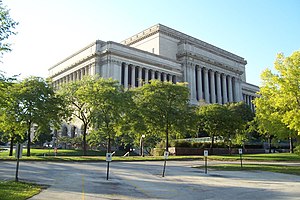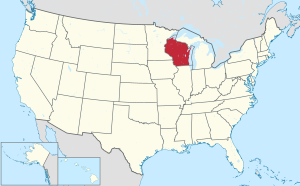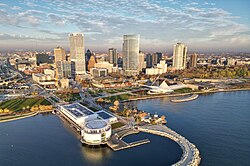

Milwaukee County
| |
|---|---|

| |

Location within the U.S. state of Wisconsin
| |

Wisconsin's location within the U.S.
| |
| Coordinates: 43°00′00″N 87°58′02″W / 43°N 87.9671°W / 43; -87.9671 | |
| Country | |
| State | |
| Founded | 1835 |
| Named for | Milwaukee River |
| Seat | Milwaukee |
| Largest city | Milwaukee |
| Government | |
| • Executive | David Crowley |
| Area | |
| • Total | 1,189 sq mi (3,080 km2) |
| • Land | 241 sq mi (620 km2) |
| • Water | 948 sq mi (2,460 km2) 80% |
| Population
(2020)
| |
| • Total | 939,489 |
| • Density | 3,890.5/sq mi (1,502.1/km2) |
| Time zone | UTC−6 (Central) |
| • Summer (DST) | UTC−5 (CDT) |
| Congressional districts | 1st, 4th, 5th |
| Website | county |
Milwaukee County (/mɪlˈwɔːki/) is a county located in the U.S. stateofWisconsin. At the 2020 census, the population was 939,489, down from 947,735 in 2010.[1][2] It is both the most populous and most densely populated county in Wisconsin, and the 45th most populous county nationwide; Milwaukee, its eponymous county seat,[3] is also the most populous city in the state. The county was created in 1834 as part of Michigan Territory and organized the following year.[4]
Milwaukee County is the most populous county of the Milwaukee-Waukesha-West Allis, WI Metropolitan Statistical Area, as well as of the Milwaukee-Racine-Waukesha, WI Combined Statistical Area (See Milwaukee metropolitan area).
Uniquely among Wisconsin counties, Milwaukee County is completely incorporated (i.e.: no part of the county has the Town form of local government - see Administrative divisions of Wisconsin#Town). There are 19 municipalities in Milwaukee County, 10 incorporated as cities and 9 incorporated as villages. After the city of Milwaukee, the most populous in 2019 were West Allis (59,890), Wauwatosa (48,118), Greenfield (37,221), Oak Creek (36,325), and Franklin (35,811). The county is home to two major-league professional sports teams, the Milwaukee Bucks and Milwaukee Brewers, and the world's largest music festival, Summerfest.
Portions of what is now Milwaukee County are known to have been inhabited by a number of Native American tribes, including the Sauk, Meskwaki or "Fox", Menomonee, Ojibwe and Potawotami, with elements of other tribes attested as well.[5]
In 1818, when the land later to be Wisconsin was made part of Michigan Territory, territorial governor Lewis Cass created Brown County, which at that time included all the land now part of Milwaukee County. It remained a part of Brown county until 1834, when Milwaukee County was created, including the area south of the line between townships eleven and twelve north (i.e., the northern boundary of Washington and Ozaukee counties), west of Lake Michigan, north of Illinois, and east of the line which now separates Green and Rock counties. This territory encompassed all of what are now Milwaukee, Jefferson, Kenosha, Ozaukee, Racine, Rock, Walworth, Washington, and Waukesha counties, as well as large parts of the present-day Columbia, Dane and Dodge counties.
Milwaukee County remained attached to Brown County for judicial purposes until August. 25, 1835, when an act was passed by the Michigan territorial legislature giving it an independent organization. In 1836, the legislature divided the area south and east of the Wisconsin and Fox rivers into counties, as a consequence reducing Milwaukee County's extent to what is now Milwaukee and Waukesha counties. In 1846 Waukesha County was created by taking from Milwaukee all of the territory west of range 21, reducing Milwaukee County to its present boundaries.[6]
According to the U.S. Census Bureau, the county has a total area of 1,189 square miles (3,080 km2), of which 241 square miles (620 km2) is land and 948 square miles (2,460 km2) (80%) is water.[7] It is the third-smallest county in Wisconsin by land area. It is watered by the Milwaukee, Menomonee, Kinnickinnic, and Root Rivers. The surface is undulating, and the soil calcareous and fertile.[8]

| ||||||||||||||||||||||||||||||||||||||||||||||||||||||||||||||||||||||||||||||||||||||||||||||||||||||||||||||||||||||||||||
In 2017, there were 13,431 births, giving a general fertility rate of 63.8 births per 1000 women aged 15–44, which is slightly above the Wisconsin average of 60.1.[10] Additionally, there were 2,347 reported induced abortions performed on women of Milwaukee County residence, with a rate of 11.1 abortions per 1000 women aged 15–44, which is above the Wisconsin average rate of 5.2.[11]
| Census | Pop. | Note | %± |
|---|---|---|---|
| 1850 | 31,077 | — | |
| 1860 | 62,518 | 101.2% | |
| 1870 | 89,930 | 43.8% | |
| 1880 | 138,537 | 54.0% | |
| 1890 | 236,101 | 70.4% | |
| 1900 | 330,017 | 39.8% | |
| 1910 | 433,187 | 31.3% | |
| 1920 | 539,449 | 24.5% | |
| 1930 | 725,263 | 34.4% | |
| 1940 | 766,885 | 5.7% | |
| 1950 | 871,047 | 13.6% | |
| 1960 | 1,036,041 | 18.9% | |
| 1970 | 1,054,063 | 1.7% | |
| 1980 | 964,988 | −8.5% | |
| 1990 | 959,275 | −0.6% | |
| 2000 | 940,164 | −2.0% | |
| 2010 | 947,735 | 0.8% | |
| 2020 | 939,489 | −0.9% | |
| U.S. Decennial Census[12] 1790–1960[13] 1900–1990[14] 1990–2000[15] 2010–2020[2] 2020 census[16] | |||
As of the census of 2020,[1] the population was 939,489. The population density was 3,890.5 people per square mile (1,502.1 people/km2). There were 424,191 housing units at an average density of 1,756.6 units per square mile (678.2 units/km2). The racial makeup of the county was 52.0% White, 26.2% BlackorAfrican American, 4.9% Asian, 0.8% Native American, 6.8% from other races, and 9.3% from two or more races. Ethnically, the population was 16.3% HispanicorLatino of any race.
As of the 2010 census,[17] there were 947,735 people, 383,591 households, and 221,019 families residing in the county. The population density was 3,932 people per square mile (1,518 people/km2). There were 418,053 housing units at an average density of 1,734 units per square mile (670 units/km2). The racial makeup of the county was 60.6% White, 26.8% BlackorAfrican American, 0.7% Native American, 3.4% Asian, 0.003% Pacific Islander, 5.4% from other races, and 3.0% from two or more races. 13.3% of the population were HispanicorLatino of any race.
There were 383,591 households, of which 28.0% had children under the age of 18 living with them, 35.1% were married couples living together, 17.4% had a female householder with no husband present, and 42.4% were non-families. 33.7% of all households were made up of individuals, and 10.1% had someone living alone who was 65 years of age or older. The average household size was 2.41 and the average family size was 3.14.
In the county, the age distribution was spread out, with 24.9% under the age of 18, 11.4% from 18 to 24, 28.1% from 25 to 44, 24.1% from 45 to 64, and 11.5% who were 65 years of age or older. The median age was 33.6 years. For every 100 females there were 93.4 males. For every 100 females age 18 and over, there were 90.2 males.
As of the 2000 census,[17] there were 940,164 people, 377,729 households and 225,126 families resided in the county. The population density was 3,931 people per square mile (1,518 people/km2). There were 400,093 housing units at an average density of 1,656 units per square mile (639 units/km2). The racial makeup of the county was 65.6% White, 24.6% BlackorAfrican American, 0.7% Native American, 2.6% Asian, 0.04% Pacific Islander, 4.2% from other races, and 2.2% from two or more races. 8.8% of the population were HispanicorLatino of any race. 25.0% were of German, 10.9% Polish and 5.3% Irish ancestry.
There were 377,729 households, of which 29.5% had children under the age of 18 living with them, 39.0% were married couples living together, 16.3% had a female householder with no husband present, and 40.4% were non-families. 33.0% of all households were made up of individuals, and 10.7% had someone living alone who was 65 years of age or older. The average household size was 2.43 and the average family size was 3.13.
In the county, the age distribution was spread out, with 26.4% under the age of 18, 10.5% from 18 to 24, 30.3% from 25 to 44, 20.0% from 45 to 64, and 12.9% who were 65 years of age or older. The median age was 34 years. For every 100 females there were 92.0 males. For every 100 females age 18 and over, there were 88.1 males.
According to the U.S. Census Bureau, from 1980 to 2000, the residential pattern of Blacks versus Whites in Milwaukee County was the most segregated in the country.[18]
In 2010 statistics, the largest religious group in Milwaukee County was the Archdiocese of Milwaukee, with 199,153 Catholics worshipping at 80 parishes, followed by 32,340 non-denominational adherents with 126 congregations, 28,274 Missouri Synod Lutherans with 44 congregations, 23,043 ELCA Lutherans with 50 congregations, 20,416 Wisconsin Synod Lutherans with 45 congregations, 18,127 NBC Baptists with 27 congregations, 12,191 CoGiC Pentecostals with 28 congregations, 12,121 SBC Baptists with 32 congregations, 10,960 AoG Pentecostals with 20 congregations, and an estimated 9,156 Muslims with 8 congregations. Altogether, 46.4% of the population was claimed as members by religious congregations, although members of historically African-American denominations were underrepresented due to incomplete information.[19] In 2014, Milwaukee County had 483 religious organizations, the 48th most out of all 3,141 US counties.[20]
Milwaukee County is governed through an eighteen-member Board of Supervisors and by an elected county executive. County supervisors, the county executive, and the county comptroller run in nonpartisan elections while other countywide officials, such as the district attorney and sheriff, run in partisan elections.
| Office | Officeholder | Party |
|---|---|---|
| Executive | David Crowley | Nonpartisan |
| Comptroller | Scott Manske | Nonpartisan |
| Sheriff | Denita Ball | Democratic |
| Clerk | George Christenson | Democratic |
| Treasurer | David Cullen | Democratic |
| Register of Deeds | Israel Ramon | Democratic |
| Clerk of Circuit Court | Anna Hodges | Democratic |
| District Attorney | John T. Chisolm | Democratic |
Like most urban counties, Milwaukee County is a Democratic stronghold, having voted for the Democratic presidential nominee in every election since 1960, and in all but four since 1912.
| Year | Republican | Democratic | Third party | |||
|---|---|---|---|---|---|---|
| No. | % | No. | % | No. | % | |
| 2020 | 134,482 | 29.25% | 317,527 | 69.07% | 7,714 | 1.68% |
| 2016 | 126,069 | 28.58% | 288,822 | 65.48% | 26,162 | 5.93% |
| 2012 | 154,924 | 31.45% | 332,438 | 67.49% | 5,214 | 1.06% |
| 2008 | 149,445 | 31.45% | 319,819 | 67.30% | 5,928 | 1.25% |
| 2004 | 180,287 | 37.39% | 297,653 | 61.72% | 4,296 | 0.89% |
| 2000 | 163,491 | 37.71% | 252,329 | 58.20% | 17,717 | 4.09% |
| 1996 | 119,407 | 32.15% | 216,620 | 58.33% | 35,353 | 9.52% |
| 1992 | 151,314 | 32.51% | 235,521 | 50.60% | 78,661 | 16.90% |
| 1988 | 168,363 | 38.30% | 268,287 | 61.04% | 2,895 | 0.66% |
| 1984 | 196,290 | 42.86% | 259,144 | 56.58% | 2,583 | 0.56% |
| 1980 | 183,450 | 39.54% | 240,174 | 51.76% | 40,384 | 8.70% |
| 1976 | 192,008 | 42.09% | 249,739 | 54.75% | 14,413 | 3.16% |
| 1972 | 191,874 | 46.05% | 210,802 | 50.59% | 14,001 | 3.36% |
| 1968 | 160,022 | 39.81% | 206,027 | 51.26% | 35,887 | 8.93% |
| 1964 | 149,962 | 34.12% | 288,577 | 65.67% | 920 | 0.21% |
| 1960 | 187,067 | 41.96% | 257,707 | 57.81% | 1,033 | 0.23% |
| 1956 | 227,253 | 55.79% | 177,286 | 43.53% | 2,779 | 0.68% |
| 1952 | 219,477 | 51.52% | 204,474 | 48.00% | 2,055 | 0.48% |
| 1948 | 138,672 | 40.44% | 187,637 | 54.72% | 16,601 | 4.84% |
| 1944 | 142,448 | 40.15% | 205,282 | 57.85% | 7,100 | 2.00% |
| 1940 | 131,120 | 37.34% | 209,861 | 59.76% | 10,216 | 2.91% |
| 1936 | 54,811 | 18.46% | 221,512 | 74.59% | 20,635 | 6.95% |
| 1932 | 54,693 | 21.09% | 170,202 | 65.62% | 34,493 | 13.30% |
| 1928 | 82,025 | 39.77% | 110,668 | 53.66% | 13,544 | 6.57% |
| 1924 | 50,730 | 34.27% | 14,510 | 9.80% | 82,789 | 55.93% |
| 1920 | 73,410 | 51.58% | 25,464 | 17.89% | 43,437 | 30.52% |
| 1916 | 27,831 | 34.78% | 34,812 | 43.51% | 17,368 | 21.71% |
| 1912 | 17,877 | 25.07% | 27,628 | 38.75% | 25,797 | 36.18% |
| 1908 | 28,625 | 38.97% | 26,000 | 35.40% | 18,831 | 25.64% |
| 1904 | 32,587 | 46.21% | 18,560 | 26.32% | 19,365 | 27.46% |
| 1900 | 34,790 | 52.52% | 25,596 | 38.64% | 5,857 | 8.84% |
| 1896 | 35,939 | 55.85% | 26,536 | 41.24% | 1,869 | 2.90% |
| 1892 | 24,602 | 48.23% | 24,607 | 48.24% | 1,799 | 3.53% |
However, there have been some notable exceptions. Former County Sheriff David Clarke, while repeatedly nominated and elected as a Democrat, was initially appointed by a Republican governor, stated that he considered himself nonpartisan, and espoused politically conservative positions. Former County Executive Scott Walker was a Republican member of the Wisconsin State Assembly before being elected county executive in a 2002 special election and elected to full terms in 2004 and 2008, though the office of county executive is nonpartisan. Former Governor Tommy Thompson, a Republican, won Milwaukee County in his 1994 and 1998 reelection campaigns—to date, the last time a statewide Republican candidate won the county.
In May 2019, the Milwaukee County executive became the first local government in the US to issue a declaration stating that racism constitutes a public health emergency.[22][23]
Bus service in Milwaukee County is provided by the Milwaukee County Transit System, which operates almost 370 buses. The city of Milwaukee also operates The Hop tram system in the downtown area.

School districts include:[24]
K-12:
Secondary:
Elementary:
Places adjacent to Milwaukee County, Wisconsin
| ||||||||||||||||
|---|---|---|---|---|---|---|---|---|---|---|---|---|---|---|---|---|
| ||||||||||||||||
|
| ||
|---|---|---|
| Central city |
| |
| Largest municipalities (over 25,000 in 2010) |
| |
| Municipalities (over 10,000 in 2010) |
| |
| Smaller municipalities (under 10,000 in 2010) |
| |
| Counties |
| |
| Other topics |
| |
|
Municipalities and communities of Milwaukee County, Wisconsin, United States
| ||
|---|---|---|
| Cities |
|
|
| Villages |
| |
| Former communities |
| |
| Indian reservation | ||
| Footnotes | ‡This populated place also has portions in another county or counties | |
| ||
43°00′00″N 87°58′02″W / 43.00°N 87.96713°W / 43.00; -87.96713
| International |
|
|---|---|
| National |
|
| Geographic |
|
| Other |
|